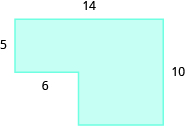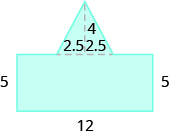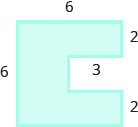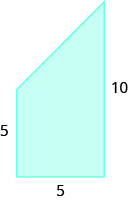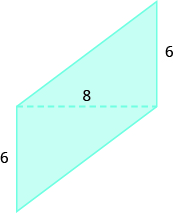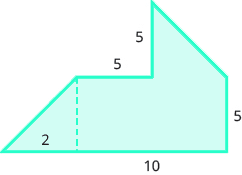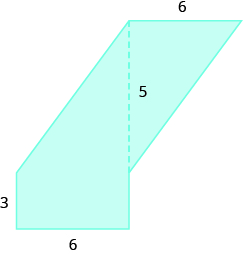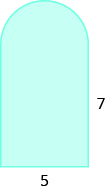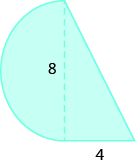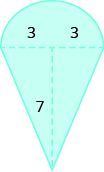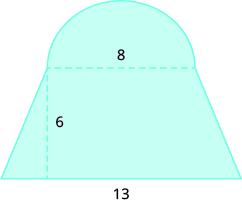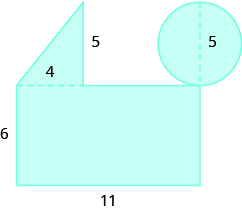7.3: Solve Geometry Applications — Circles & Irregular Figures
In this section, we’ll continue working with geometry applications. We will add several new formulas to our collection of formulas. To help you as you do the examples and exercises in this section, we will show the problem-solving strategy for geometry applications here.
Problem-solving strategy for geometry applications:
- Read the problem and make sure you understand all the words and ideas. Draw the figure and label it with the given information.
- Identify what you are looking for.
- Name what you are looking for. Choose a variable to represent that quantity.
- Translate into an equation by writing the appropriate formula or model for the situation. Substitute in the given information.
- Solve the equation using good algebra techniques.
- Check the answer to the problem and make sure it makes sense.
- Answer the question with a complete sentence.
Use the Properties of Circles
We will refer to the properties of circles as we use them to solve applications.
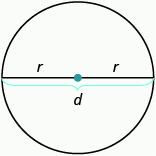
- r is the length of the radius.
- d is the length of the diametre.
- [latex]d=2r[/latex]
- Circumference is the perimeter of a circle. The formula for circumference is [latex]C=2\pi r[/latex]
- The formula for the area of a circle is [latex]A=\pi {r}^{2}[/latex]
(see Figure 7.3.1)
Remember: We approximate [latex]\pi[/latex] with 3.14 or [latex]\tfrac{22}{7}[/latex] depending on whether the radius of the circle is given as a decimal or a fraction.
If you use the [latex]\pi[/latex] key on your calculator to do the calculations in this section, your answers will be slightly different from the answers shown. That is because the [latex]\pi[/latex] key uses more than two decimal places.
Example A
A circular sandbox has a radius of 2.5 feet. Find the a) circumference and b) area of the sandbox.
Step 1: Read the problem. Draw the figure and label it with the given information (see Figure 7.3.2).
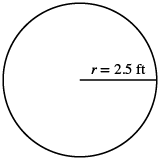
a. Circumference
Step 2: Identify what you are looking for.
The circumference of the circle.
Step 3: Name. Choose a variable to represent it.
Let c = circumference of the circle
Step 4: Translate. Write the appropriate formula. Substitute. (Use 3.14 for [latex]\pi[/latex])
[latex]\begin{equation}\begin{split}C&=2\pi r \\ C&=2(3.14)(2.5) \end{split}\end{equation}[/latex]
Step 5: Solve the equation.
[latex]C\approx 15[/latex]
Step 6: Check. Does this answer make sense?
Yes. If we draw a square around the circle, its sides would be 5 ft (twice the radius), so its perimeter would be 20 ft (see Figure 7.3.3). This is slightly more than the circle’s circumference, 15.7 ft.
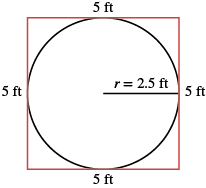
Step 7: Answer the question.
The circumference of the sandbox is 15.7 feet.
b. Area
Step 2: Identify what you are looking for.
The area of the circle.
Step 3: Name. Choose a variable to represent it.
Let A = the area of the circle
Step 4: Translate. Write the appropriate formula. Substitute. (Use 3.14 for [latex]\pi[/latex])
[latex]\begin{equation}\begin{split}A&=\pi r^2 \\ A&\approx (3.14)2.5^2 \end{split}\end{equation}[/latex]
Step 5: Solve the equation.
[latex]A\approx 19.625[/latex]
Step 6: Check. Does this answer make sense?
Yes. If we draw a square around the circle, its sides would be 5 ft, as shown in part a). So the area of the square would be 25 sq. ft. This is slightly more than the circle’s area, 19.625 sq. ft.
Step 7: Answer the question.
The area of the circle is 19.625 square feet.
Exercise 1
A circular mirror has a radius of 5 inches. Find the a) circumference and b) area of the mirror.
Exercise 1 Answers
- 31.4 in.
- 78.5 sq. in.
Exercise 2
A circular spa has a radius of 4.5 feet. Find the a) circumference and b) area of the spa.
Exercise 2 Answers
- 28.26 ft
- 63.585 sq. ft
We usually see the formula for circumference in terms of the radius r of the circle:
[latex]C=2\pi r[/latex]
However, since the diametre of a circle is two times the radius, we could write the formula for the circumference in terms [latex]\text{of}\phantom{\rule{0.2em}{0ex}}d[/latex].
[latex]\begin{array}{cccc}& & & C=2\pi r\hfill \\ \text{Using the commutative property, we get}\hfill & & & C=\pi \cdot2r\hfill \\ \text{Then substituting}\phantom{\rule{0.2em}{0ex}}d=2r\hfill & & & C=\pi \cdot\text{d}\hfill \\ \text{So}\hfill & & & C=\pi d\hfill \end{array}[/latex]
We will use this form of the circumference when we’re given the length of the diametre instead of the radius.
Example B
A circular table has a diametre of four feet. What is the circumference of the table?
Step 1: Read the problem. Draw the figure and label it with the given information (see Figure 7.3.4).

Step 2: Identify what you are looking for.
The circumference of the table.
Step 3: Name. Choose a variable to represent it.
Let c = the circumference of the table
Step 4: Translate. Write the appropriate formula. Substitute. (Use 3.14 for [latex]\pi[/latex])
[latex]\begin{equation}\begin{split}C&=\pi d \\ C&\approx (3.14)(4) \end{split}\end{equation}[/latex]
Step 5: Solve the equation.
[latex]C\approx 12.56[/latex]
Step 6: Check.
If we put a square around the circle, its side would be 4 (see Figure 7.3.5).
The perimeter would be 16. It makes sense that the circumference of the circle, 12.56, is a little less than 16.
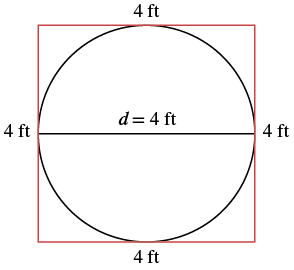
Step 7: Answer the question.
The diametre of the table is 12.56 square feet.
Exercise 3
Find the circumference of a circular fire pit whose diametre is 5.5 feet.
Exercise 3 Answer
17.27 ft
Exercise 4
If the diametre of a circular trampoline is 12 feet, what is its circumference?
Exercise 4 Answer
37.68 ft
Example C
Find the diametre of a circle with a circumference of 47.1 centimetres.
Step 1: Read the problem. Draw the figure and label it with the given information (see Figure 7.3.6).

Step 2: Identify what you are looking for.
The diametre of the circle.
Step 3: Name. Choose a variable to represent it.
Let d = the diametre of the circle
Step 4: Translate. Write the appropriate formula. Substitute. (Use 3.14 for [latex]\pi[/latex])
[latex]\begin{equation}\begin{split}C&=\pi d \\ 47.1&\approx (3.14)d \end{split}\end{equation}[/latex]
Step 5: Solve.
[latex]\begin{equation}\begin{split}\dfrac{47.1}{3.14} &\approx \dfrac{3.14d}{3.14} \\ 15&\approx d \end{split}\end{equation}[/latex]
Step 6: Check.
[latex]\begin{equation}\begin{split}C&\approx \pi d \\ 47.1&=(3.14)(15) ? \\ 47.1&=47.1 \text{ ✔} \end{split}\end{equation}[/latex]
Step 7: Answer the question.
The diametre of the circle is approximately 15 centimetres.
Exercise 5
Find the diametre of a circle with a circumference of 94.2 centimetres.
Exercise 5 Answer
30 cm
Exercise 6
Find the diametre of a circle with a circumference of 345.4 feet.
Exercise 6 Answer
110 ft
Find the Area of Irregular Figures
So far, we have found the areas for rectangles, triangles, trapezoids, and circles. An irregular figure is a figure that is not a standard geometric shape. Its area cannot be calculated using any of the standard area formulas.
However, some irregular figures are made up of two or more standard geometric shapes. To find the area of one of these irregular figures, we can split it into figures whose formulas we know and then add the areas of the figures.
Example D
Find the area of the shaded region in Figure 7.3.7.
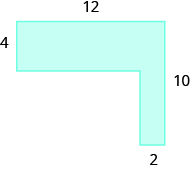
The given figure is irregular, but we can break it into two rectangles. The area of the shaded region will be the sum of the areas of both rectangles (see Figure 7.3.8).
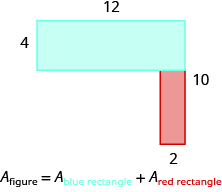
The blue rectangle has a width of 12 and a length of 4. The red rectangle has a width of 2, but its length is not labelled. The right side of the figure is the length of the red rectangle plus the length of the blue rectangle. Since the right side of the blue rectangle is 4 units long, the length of the red rectangle must be 6 units (see Figure 7.3.9).

[latex]\begin{equation}\begin{split}{A}_{\text{figure}}&={A}_{\textcolor{blue}{\text{rectangle}}}+{A}_{\textcolor{red}{\text{rectangle}}} \\ {A}_{\text{figure}}&=\textcolor{blue}{bh}+\textcolor{red}{bh} \\ {A}_{\text{figure}}&=\textcolor{blue}{12 \cdot 4}+\textcolor{red}{2 \cdot 6} \\ {A}_{\text{figure}}&=\textcolor{blue}{48}+\textcolor{red}{12} \\ {A}_{\text{figure}}&= 60 \end{split}\end{equation}[/latex]
The area of the figure is 60 square units.
Is there another way to split this figure into two rectangles? Try it, and make sure you get the same area.
Exercise 7
Exercise 8
Example E
Find the area of the shaded region in Figure 7.3.12.

Step 1: We can break this irregular figure into a triangle and a rectangle. The area of the figure will be the sum of the areas of the triangle and rectangle.
The rectangle has a length of 8 units and a width of 4 units.
We need to find the base and height of the triangle.
Since both sides of the rectangle are 4, the vertical side of the triangle is 3, which is [latex]7-4[/latex].
The length of the rectangle is 8, so the base of the triangle will be 3, which is [latex]8-4[/latex] (see Figure 7.3.13).
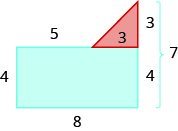
Step 2: Now, we can add the areas to find the area of the irregular figure.
[latex]\begin{equation}\begin{split}{A}_{\text{figure}}&={A}_{\textcolor{blue}{\text{rectangle}}}+{A}_{\textcolor{red}{\text{triangle}}} \\ {A}_{\text{figure}}&=\textcolor{blue}{lw}+\dfrac{1}{2}\textcolor{red}{bh} \\ {A}_{\text{figure}}&=\textcolor{blue}{8 \cdot 4}+\dfrac{1}{2}\cdot \textcolor{red}{3 \cdot 3} \\ {A}_{\text{figure}}&=\textcolor{blue}{32}+\textcolor{red}{4.5} \\ {A}_{\text{figure}}&=36.5\text{ sq. units}\end{split}\end{equation}[/latex]
The area of the figure is 36.5 square units.
Exercise 9
Find the area of each shaded region in Figure 7.3.14.

Exercise 9 Answer
36.5 sq. units
Exercise 10
Example F
A high school track is shaped like a rectangle with a semi-circle (half a circle) on each end (see Figure 7.3.16). The rectangle has a length of 105 metres and a width of 68 metres. Find the area enclosed by the track. Round your answer to the nearest hundredth.
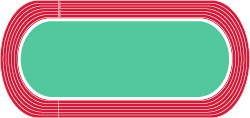
We will break the figure into a rectangle and two semi-circles. The area of the figure will be the sum of the areas of the rectangle and the semi-circles.
The rectangle has a length of 105 m and a width of 68 m. The semi-circles have a diametre of 68 m, so each has a radius of 34 m (see Figure 7.3.17).
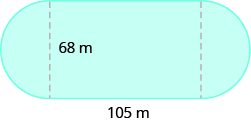
[latex]\begin{equation}\begin{split}{A}_{\text{figure}}&={A}_{\textcolor{blue}{\text{rectangle}}}+{A}_{\textcolor{red}{\text{semi-circles}}} \\ {A}_{\text{figure}}&=\textcolor{blue}{bh}+\textcolor{red}{2(\dfrac{1}{2} \pi \cdot r^2)} \\ {A}_{\text{figure}} & \approx \textcolor{blue}{105 \cdot 68} + \textcolor{red}{2(\dfrac{1}{2} \cdot 3.14 \cdot 34^2)} \\ {A}_{\text{figure}} & \approx \textcolor{blue}{7140}+\textcolor{red}{3629.84} \\ {A}_{\text{figure}} & \approx 10\,769.84 \text{ square metres}\end{split}\end{equation}[/latex]
The area of the track is 10769.84 m2.
Exercise 11
Exercise 12
Additional online resources:
- Circumference of a Circle — Examples: Determine the Circumference of a Circle [2:59 min] (Mathispower4u, 2011e).
- Area of a Circle — Example: Determine the Area of a Circle [2:57 min] (Mathispower4u, 2011d).
- Area of an L-shaped Polygon — Ex: Find the Area of an L-Shaped Polygon Involving Whole Numbers [3:19 min] (Mathispower4u, 2011f).
- Area of an L-shaped Polygon with Decimals — Example: Determine the Area of an L-Shaped Polygon Using Decimals [5:01 min] (Mathispower4u, 2011a).
- Perimeter Involving a Rectangle and Circle — Example: Determine Perimeter Involving a Rectangle and Circle [3:05 min] (Mathispower4u, 2011c).
- Area Involving a Rectangle and Circle — Example: Determine an Area Involving a Rectangle and Circle [3:10 min] (Mathispower4u, 2011b).
Key Concepts
Problem Solving Strategy for Geometry Applications
-
- Read the problem and make sure you understand all the words and ideas. Draw the figure and label it with the given information.
- Identify what you are looking for.
- Name what you are looking for. Choose a variable to represent that quantity.
- Translate into an equation by writing the appropriate formula or model for the situation. Substitute in the given information.
- Solve the equation using good algebra techniques.
- Check the answer to the problem and make sure it makes sense.
- Answer the question with a complete sentence.
Properties of Circles
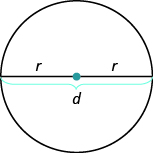
- [latex]d=2r[/latex]
- Circumference: [latex]C=2\pi[/latex] r or [latex]C=\pi d[/latex]
- Area: A[latex]=\pi {r}^{2}[/latex]
- (see Figure 7.3.20)
Glossary
- Irregular figure — An irregular figure is a figure that is not a standard geometric shape. Its area cannot be calculated using any of the standard area formulas.
7.3: Practice Questions
1. Use the Properties of Circles
In the following exercises, solve using the properties of circles.
- The lid of a paint bucket is a circle with a radius of 7 inches. Find the a) circumference and b) area of the lid.
- An extra-large pizza is a circle with a radius of 8 inches. Find the a) circumference and b) area of the pizza.
- A farm sprinkler spreads water in a circle with a radius of 8.5 feet. Find the a) circumference and b) area of the watered circle.
- A circular rug has a radius of 3.5 feet. Find the a) circumference and b) area of the rug.
- A reflecting pool is in the shape of a circle with a diametre of 20 feet. What is the circumference of the pool?
- A turntable is a circle with a diametre of 10 inches. What is the circumference of the turntable?
- A circular saw has a diametre of 12 inches. What is the circumference of the saw?
- A round coin has a diametre of 3 centimetres. What is the circumference of the coin?
- A barbecue grill is a circle with a diametre of 2.2 feet. What is the circumference of the grill?
- The top of a pie tin is a circle with a diametre of 9.5 inches. What is the circumference of the top?
- A circle has a circumference of 163.28 inches. Find the diametre.
- A circle has a circumference of 59.66 feet. Find the diametre.
- A circle has a circumference of 17.27 metres. Find the diametre.
- A circle has a circumference of 80.07 centimetres. Find the diametre.
In the following exercises, find the radius of the circle with the given circumference.
- A circle has a circumference of 150.72 feet.
- A circle has a circumference of 251.2 centimetres.
- A circle has a circumference of 40.82 miles.
- A circle has a circumference of 78.5 inches.
2. Find the Area of Irregular Figures
In the following exercises, find the area of the irregular figure. Round your answers to the nearest hundredth.
In the following exercises, solve.
- A city park covers one block plus parts of four more blocks, as shown in Figure 7.3.21. The block is a square with sides 250 feet long, and the triangles are isosceles right triangles. Find the area of the park.

Figure 7.3.21 - A gift box will be made from a rectangular piece of cardboard measuring 12 inches by 20 inches, with squares cut out of the corners of the sides, as shown in Figure 7.3.22. The sides of the squares are 3 inches. Find the area of the cardboard after the corners are cut out.

Figure 7.3.22 - Perry needs to put in a new lawn. His lot is a rectangle with a length of 120 feet and a width of 100 feet. The house is rectangular and measures 50 feet by 40 feet. His driveway is rectangular and measures 20 feet by 30 feet, as shown in Figure 7.3.23. Find the area of Perry’s lawn.
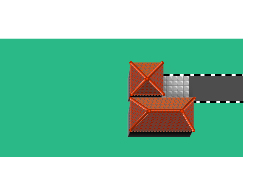
Figure 7.3.23 - Denise is planning to put a deck in her backyard. The deck will be a 20-ft by 12-ft rectangle with a semicircle of diametre 6 feet, as shown in Figure 7.3.24. Find the area of the deck.
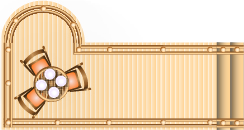
Figure 7.3.24
3. Everyday Math
- Area of a Tabletop: Yuki bought a drop-leaf kitchen table. The rectangular part of the table is a 1-ft by 3-ft rectangle with a semicircle at each end, as shown in Figure 7.3.25.
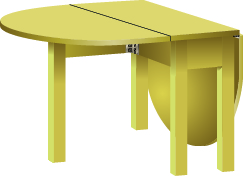
Figure 7.3.25 - Find the area of the table with one leaf up.
- Find the area of the table with both leaves up.
- Painting: Leora wants to paint the nursery in her house. The nursery is an 8-ft by 10-ft rectangle, and the ceiling is 8 feet tall. There is a 3-ft by 6.5-ft door on one wall, a 3-ft by 6.5-ft closet door on another wall, and one 4-ft by 3.5-ft window on the third wall. The fourth wall has no doors or windows. If she will only paint the four walls and not the ceiling or doors, how many square feet will she need to paint?
4. Writing Exercises
- Describe two different ways to find the area of Figure 7.3.26, and then show your work to make sure both ways give the same area.
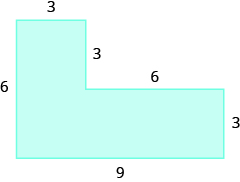
Figure 7.3.26 - A circle has a diametre of 14 feet. Find the area of the circle
- Using 3.14 for [latex]\pi[/latex].
- Using [latex]\tfrac{22}{7}[/latex] for [latex]\pi[/latex].
- Which calculation to do prefer? Why?
7.3: Practice Answers
- Use the properties of circles
- C = 43.96 in.
A = 153.86 sq. in. - C = 53.38 ft
A = 226.865 sq. ft - 62.8 ft
- 37.68 in.
- 6.908 ft
- 52 in.
- 5.5 m
- 24 ft
- 6.5 mi
- C = 43.96 in.
- Find the area of irregular figures
- 16 sq. units
- 30 sq. units
- 57.5 sq. units
- 12 sq. units
- 67.5 sq. units
- 89 sq. units
- 44.81 sq. units
- 41.12 sq. units
- 35.13 sq. units
- 95.625 sq. units
- 187,500 sq. ft
- 9400 sq. ft
- Everyday math.
- Area of a Tabletop.
- 6.5325 sq. ft
- 10.065 sq. ft
- Area of a Tabletop.
- Writing exercises
- Answers will vary.
References
Mathispower4u. (2011a, June 17). Example: Determine the area of an L-shaped polygon using decimals [Video]. YouTube. https://youtu.be/roRp3BjHwbU?si=gFXn80n90TVE2tM6.
Mathispower4u. (2011b, June 21). Example: Determine an area involving a rectangle and circle [Video]. YouTube. https://youtu.be/085t_Fmje4o?si=p8ElBx_v3oqEPsrw.
Mathispower4u. (2011c, June 21). Example: Determine perimeter involving a rectangle and circle [Video]. YouTube. https://youtu.be/fW2Ly8WFHzU?si=2codTCp-I45piJ3d.
Mathispower4u. (2011d, June 21). Example: Determine the area of a circle [Video]. YouTube. https://youtu.be/SIKkWLqt2mQ?si=1ggAEqaNrQbdZ1DI.
Mathispower4u. (2011e, June 21). Examples: Determine the circumference of a circle [Video]. YouTube. https://youtu.be/sHtsnC2Mgnk?si=L9jRfnkFQm2U7ClR.
Mathispower4u. (2011f, August 5). Ex: Find the area of an L-shaped polygon involving whole numbers [Video]. YouTube. https://youtu.be/lx8vweYTPpg?si=PET4FPjfwI-p_xyZ.
Attributions
All figures in this chapter are from 3.4 Solve Geometry Applications: Circles and Irregular Figures in Introductory Algebra by Izabela Mazur, via BCcampus.
This chapter has been adapted from 3.4 Solve Geometry Applications: Circles and Irregular Figures in Introductory Algebra (BCcampus) by Izabela Mazur (2021), which is under a CC BY 4.0 license.
The original chapter was adapted from 9.5 Solve Geometry Applications: Circles and Irregular Figures in Prealgebra 2e (OpenStax) by Lynn Marecek, MaryAnne Anthony-Smith, and Andrea Honeycutt Mathis (2020), which is under a CC BY 4.0 license. Adapted by Izabela Mazur.


